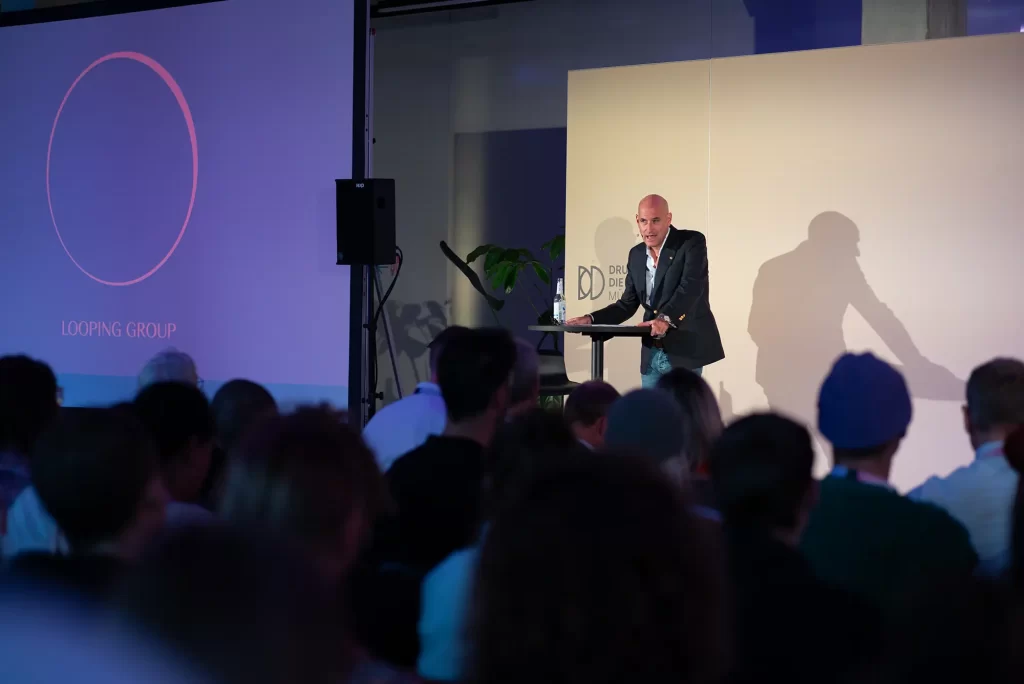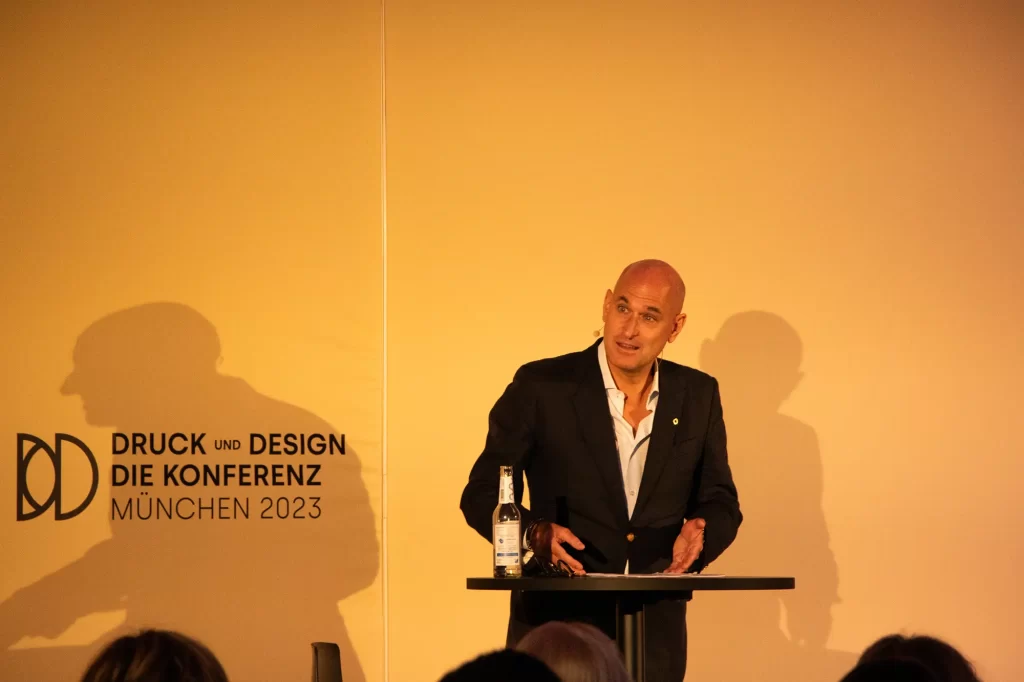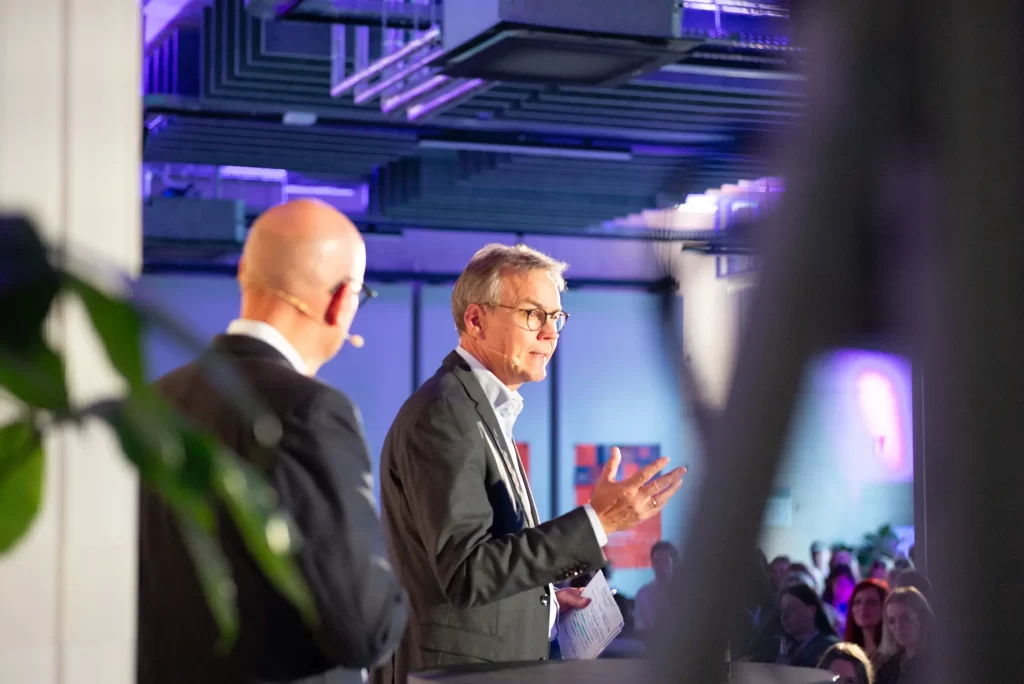In October 2023, Druck & Design once again brought together paper and print professionals and creative minds in Munich. Dominik Wichmann from the Looping Group opened the conference with his keynote speech, outlining how print will develop in the future and what print products need to achieve in order to remain relevant. His analysis generated genuine enthusiasm in the audience, which is why we would like to make Dominik Wichmann's keynote speech available again here at the request of many guests.

Dominik Wichmann
Co-Founder and Chief Creative Officer, Looping Group
Below is Dominik Wichmann's keynote speech, which he gave at the Print andDesign Conference2023 in Munich and which addresses the upheaval of the print world and the relevance of print in digital times.
The other day, perhaps a few months ago, the following scene took place in the ministerial office of the Federal Foreign Office in Berlin: the German ambassador from a distant country, let's say Mongolia for example, came to the Foreign Ministry to report to the Minister on the situation in Mongolia. He entered the minister's office, they shook hands briefly and sat down.
"Mr. Ambassador," asked the Minister, "tell me in a word: what is the situation in Mongolia?"
"Good," replied the ambassador. "Good, Minister."
"And in two words, Mr. Ambassador?"
"Not good, Minister. Not good."

The state of the printed word and the relevance of print media in the digital age is of great concern to me and certainly to many other people around us - and probably not just in the last few months. Because the question of what will be the raison d'etre of print in the future goes far beyond the concerns of an industry and a sector. Strictly speaking, we are talking about the future of a cultural topic when we think about the future of print.
Printed paper is and always has been more than just a way of recording and disseminating information. Printed paper was the "great networking medium in the development of modern Western civilization", wrote the feuilletonist Lothar Müller about paper in his book "White Magic".
According to Lothar Müller, paper was the prerequisite for our entire economic life - the physical prerequisite for paper money and bookkeeping. Paper was also the prerequisite for the entire organization of our societies - the physical prerequisite in the form of files and forms. Paper was "the setting for the invention of the modern soul" - the physical stage for billions of private diary entries and letters between friends, lovers and haters. Paper was and is a place of emotionality poured into words and images. Paper was also the arena of politics - the daily newspaper, as Hegel once put it, is the morning prayer of the modern, political thinker.
These parameters describe the actual dimension of the question of the relevance of print in the digital age. It is therefore about far more than just the level of reach, print runs, volumes, publication frequencies, sales and revenues. It is about the magic of a material. And about the new promise of an old product. It is probably about nothing less than the essence of culture: that it is never constituted by mere preservation and stagnation, but always and since time immemorial unfolds in its change, further development, refinement and the search for the future.
+ + +
If we return to the Federal Foreign Office, we return to a question and a scene that, of course, never happened. The current situation of print, in one word, is good. We can probably all agree that it can be described as "not good" in two words. At least if you take the so-called golden age of yesteryear as a benchmark.
And yet I and possibly some others in the room are reluctant to subscribe to this logic of black and white, good and bad, zero and one. Because not only do these antagonisms not correspond to lived reality, they are also an expression of binary, digital thinking. Reality, however, all too often consists of trade-offs, ambivalences and ambiguities.
What I will say below about the future of print in digital times is therefore deliberately characterized by a willingness to be ambiguous, to weigh things up. The American politician and Nobel Peace Prize winner Henry Kissinger once said that in order to be absolutely certain about something, you either have to know everything about it - or nothing at all.
Neither do I know everything about this thing, nor do I know nothing about it. I find myself somewhere in the middle. When it comes to assessing the future relevance of print, I stand before you as a so-called print man of many years' standing: I was editor-in-chief of SZ-Magazin and STERN magazines for 15 years. I have written and edited a few books, encouraged and inspired many authors to write their books, and today I publish several magazines. The company I founded prints countless tons of paper every year and then sends this paper out into the world in the form of books, illustrated books, consumer magazines and customer magazines. Nevertheless, the LOOPING GROUP, as this company is called, earns around 80 percent of its turnover not from printed matter. Instead, it does so with largely digital services.
I am telling you all this to reveal my bias as well as my position as a half-knowledgeable person. So please take my assessments on the topic of this keynote for what they are: Observations. Assumptions, thoughts full of ambivalence. No more, no less.

Let's engage in a little mind game: let's imagine that printed media had only just been invented. Let's also imagine that they had not only just been invented, but that they had achieved the circulation figures they can (still) boast of today before day one.
That's roughly how I felt two years ago when the then editor-in-chief of MADAME, the wonderful Petra Winter, called me and asked if I knew of a buyer for her magazine. Bauer Verlag in Hamburg wanted to sell it because MADAME was unfortunately making a loss. I consulted with my co-founders and some close friends and, after a few checks, we decided to buy the magazine brand. With all the debts, all the employees, all the opportunities, but also all the challenges - not to say existential problems.
As a very young company that was only four years old at the time, the LOOPING GROUP paid a six-figure purchase price for an annual loss that was no less substantial. And that in the middle of the second lockdown. When all the stores had closed and the lifestyle industry was barely advertising in printed magazines. There were many in the print industry at the time who thought we were crazy. Because did we have a plan? No, we didn't. But did we have the naive, dreamy hubris that the street would somehow come into being as we walked? We did.
As a company that until then had thought and acted almost purely digitally, this printed stack of paper suddenly found itself in the middle of the LOOPING GROUP. Incidentally, one employee even resigned in protest at this acquisition because, as a convinced blogger, she thought it was completely old school and grotesque to want to saddle up a print horse with so much time, energy and money.
However, as bleak as the situation appeared to be, it was equally positive. Because we found ourselves in a similar situation to the mind game quoted at the beginning: we had a somewhat dusty but great product in front of us. A product that still sold almost 100,000 copies every month, eleven times a year. A product for which customers, if they had taken out a subscription, even paid well in advance - without even knowing what exactly would be delivered to their homes. What an enormous advance of money and trust!
Last but not least, we had a product in front of us for which many knowledgeable, loyal and knowledgeable colleagues worked. A truly great and motivated editorial team that had been through a lot over the years. A product that was perceived as attractive by both B2C customers, i.e. readers, and B2B customers, i.e. advertisers. A product that produces month after month what is one of the most sought-after commodities of our time: attention. And on top of that, a product that has something that everyone wants: Identity, history, credibility.
Yes, Lord in heaven, where is there such a thing? Exactly: in the supposedly so completely broken, crisis-ridden print industry.
As a start-up without a lot of money, we didn't have the time to spend a lot of time analyzing the collapsing markets and customers. Instead, we repaired the airplane during the flight, so to speak. We immediately formulated a new brand and product vision. This vision was no longer about selling printed paper. Instead, we defined the new MAISON MADAME as a place that, like no other in the German-speaking world, stands for knowledge of the lives of affluent women over forty who share an interest in lifestyle topics. The aim is to know this group of women better than anyone else in the country.
The new house called MAISON MADAME has many rooms under its roof. One room contains a printed magazine: MADAME. In a second room there may be another printed magazine at some point. Another room already has its own beauty product line. In a fourth room, possibly a television series. In a fifth room, a live event. And the MONSIEUR magazine, which is enclosed several times a year, also looks at men from a woman's perspective. So the MONSIEUR also lives in this house, this MAISON MADAME. You meet him mainly in the wine cellar and the garage.
So we have turned the umbrella brand on its head. We have thought of the umbrella brand in terms of the entire property - and not just one room. Print, the printed magazine, will in future be part of a holistic media ecosystem - and no longer the top of a pyramid to which everything else has to be subordinate.
+ + +
In my opinion, the future role of the printed word will be to continue to take place, but less than before - and in a different place with a different task in this new, third communication system.
The first communication system consisted of a sender and a receiver. To put it very simply: a monk copied out a Bible, which was roughly equivalent to a life's work.
The second communication system consisted of one transmitter and an infinite number of receivers. This system lasted for a long time, from the invention of the printing press to the invention of the internet. It is a system in which presumably everyone in this room over the age of 35 grew up and was socially socialized.
One sender and an infinite number of receivers - this logic is also the logic in which we have organized our industry, our sector and, in part, our society: an editor-in-chief (almost always a man, by the way); a publisher (also almost always a man); a programme director, an artistic director. They all decided what was important for an infinite number of recipients. But also: a front page, a cover and a line that (ideally) runs through the newspaper or magazine from front to back, from top to bottom.
"All The News That's Fit To Print" is still written every day at the top left as the credo of this second communication system on the front page of the New York Times: an editor-in-chief decides for a potentially infinite number of readers what is so important about yesterday's news that it is printed in this paper today. This also formulates the actual, unspoken value proposition of a printed medium: You also pay for the certainty that what is not so important has not made it into the paper. The nothingness, the white space so to speak, is therefore just as much a part of the product as the content, the gray value.
+ + +
With the invention of the internet and, as a result, social media, the era of the third communication system began. This consists of an infinite number of senders and an infinite number of recipients. We (rightly!) perceive the resulting confusion as unsorted and chaotic.
Why? Because the communicative chaos is also accompanied by a crisis of authority. goes hand in hand with it. Who decides what is really important when one editor-in-chief no longer does? What is really important if, instead of the hierarchy on the front page, there is now a thread that is different for every user (depending on the individual data set in my luggage)? Does the crowd decide that? The wisdom of the many, which is so often in reality nothing more than a biting, sweating, angry mob?
But little by little, even in this Wild West of the third communication system, rules and authorities are developing, sometimes even market-determining monopolists. There are mechanisms in this so-called editorial society, in which everyone is also a broadcaster, an editor; there are mechanisms that need to be understood in order to find an adequate answer to the question of the future relevance of print in the digital age.
It seems crucial to me not to always use the decline of a glorious past of print as a yardstick for the uncertain future of print. Rather, a deep knowledge and appreciation of the digital as a starting point for any consideration of the new role of print is central. A new role within a thoroughly digital present.
+ + +
Before we talk about the new relevance of print in digital times, let's briefly remind ourselves what the essential role of the media has always been: to support communities in constituting themselves. It is an elitist misunderstanding of many journalists to believe that the purpose of a local newspaper (and ultimately all newspapers are local newspapers, even the "New York Times" quoted earlier, which is just the local newspaper of a cosmopolitan city), that the only purpose of a newspaper is to provide readers with news and commentary on this news.
In reality, it has always been like this: What makes us intellectually happy today will be wrapped in fish at the weekly market tomorrow at the latest. And what appears so cleverly and flamboyantly formulated on the front is often printed on the back with information that is part of a newspaper's value proposition. I'm talking about the information that helps us all to organize our social life in a particular place: How do I find a new apartment? Where can I find a new job? How do I find a new partner? Who do I sell my car to? When is the church service on All Saints' Day - and by the way: who has died again? Printed media have always been a place for all the needs and interests of a community.
Today, communities are constituted differently than in the past. Much more differentiated, much more granular, much deeper (recently, for example, I discovered a format on TikTok on the topic of "glucose" with an almost unbelievable number of followers...). Geography certainly plays a much smaller role in the definition of communities today than it used to. But media still has the role of providing the cement for stability and the oxygen to breathe for this particular community. Today, the media are called LinkedIN, Instagram, TikTok, Facebook, Tinder, Immo-Scout, mobile_de - and so on. Where there is a digital platform, there is usually at least one community. And vice versa.
However, these are communities that are no longer organized exclusively top-down. Communities whose members not only receive, but also send. They engage in co-creation. Communities whose members are sometimes scattered all over the world and not just within the circulation area of a newspaper or magazine; people who share an interest, a passion, a hobby, a concern; users who communicate with each other in English, even though English is often not their native language. In these communities, the need for content is just as great as it has always been. If not infinitely greater. But the way this content is told, produced and distributed is fundamentally different from the pre-digital era.

Within such digital communities, printed material is needed much less than before. Less and different. This truth does not result from the needs of the printing and publishing industry. This truth results from people's media usage behavior. But if an entire industry is faced with the challenge of producing a product that people no longer need, then this industry has a real problem. Unless it produces a product in the future that people don't necessarily need, but still want.
And that's exactly what I think the future will be about. Print is a product that you no longer necessarily need, but which - ideally - you would like to have. This paradox describes the essence of the luxury consumer goods industry: it produces and sells products that nobody needs to live, but which many people around the world absolutely want to have, own and consume. If this is the future purpose of print, and I am convinced that it is, then this also means that we are talking about a different, even more valuable, so to speak "printier" print - and a different function of this printed matter within largely digital communities.
In order to arrive at this new normality of print, it is advantageous, firstly, to derive its future destiny from digital (and not from a sentimental defense of the status quo ante). Secondly, we should recognize that print circulation and publication frequencies will continue to decline irreversibly. Thirdly, we must concede that the vast majority of future business models in the media industry will be organized on platforms and no longer in the form of pyramids. Fourthly, the primary task of publishers in the future will be to understand a target group - and only secondarily to produce and distribute content.
The new media companies therefore have no choice but to master all forms of content production in the long term (yes, including print, but not just print). That means social, audio, video and live as well. Fifthly, content and commerce should be consistently considered and brought together. And sixthly, the media companies of the future must succeed in recruiting experts from areas that are rarely employed in the publishing industry today, in addition to their existing staff: Data analysts, programmers, community managers, audio and video experts, SEO specialists, et cetera. The latter sounds simple. But it is not.
+ + +
Printed matter is relevant within these new media ecosystems if and because it is regarded as a luxury consumer good. But how exactly is luxury defined in this context? Today and in the future?
I have already mentioned the first characteristic: luxury is generally defined as a good that I do not need but that I would like to have. A luxury consumer good therefore does not primarily satisfy needs. Rather, it awakens desires. This makes attributes such as "workmanship", "substance", "history", "relief" and "deceleration" all the more important.
But luxury also has a second characteristic: luxury is always a commitment to irrationality, to unreasonableness. And so the consumption of a luxury good also gives us something deeply human: only a person knows that it is unreasonable to spend so much money on a car, a gold watch or a shopping trip to a delicatessen. And as contradictory as it may sound, only a human being who loves life knows that it is unreasonable to drink alcohol, smoke cigarettes and indulge in other vices. An animal would never do any of these things. A human would, even though - or precisely because - they are generally fully aware that it is unreasonable and unhealthy. Only humans indulge in unreasonableness, they disregard reason. Luxury is therefore always an expression of human self-determination and therefore individual freedom.
The third characteristic is the current change in the concept of luxury itself: Because in the world of the new luxury, inclusion will play at least as big a role as traditional exclusion. What do I mean by that? You are all familiar with the duality of the terms "luxury" and "exclusivity". At times, it almost seems as if the one is dependent on the other. Luxury is what is exclusive. And exclusive is what luxury is.
This alliance may have been entirely correct in the past. In the future, however, the concept of luxury will also change in terms of its accessibility: In the future, inclusive will be just as important as exclusive. I am bothered by the term, but the logic behind it is unambiguous: luxury brands that exclude will have a harder time in future than luxury brands that promise participation. Participation in a defined community. This is also a consequence of the editorial society in which we all live; a consequence of a public sphere that consists of senders and recipients in equal measure. Access, participation, co-determination and the human need for social distinction will be organized differently in the future than they were ten or 15 years ago.
If we consider these three characteristics of luxury, they inevitably have significant consequences for the goods in this luxury consumer goods industry. And printed matter is one of these goods.
Absolute value, an uncompromising investment in materiality, appearance and content are the consequences I mean. A buyer of a high-quality print product can only develop a passion for it if this passion has first been invested in the production of the product. This may sound esoteric to your ears, but I firmly believe that you can see and feel whether an object has been produced with passion - or just with pragmatism.
+ + +
Immediately after we bought MADAME and developed a new umbrella brand strategy for it with MAISON MADAME, we embarked on a determined cost-cutting course, which also involved parting ways with colleagues, with the familiar and the trusted. I don't want to hide that fact. We closed down the website. We negotiated new printing and paper contracts and parted company with some service providers.
But then we invested again. In new staff, in better equipment, in short: in greater value. We raised the price, suddenly played on a par with the competition and positioned the printed MADAME as a tangible ticket to a world of similarly minded readers. This world also consists of a printed magazine, but not only. Today, two years after the takeover by the LOOPING GROUP, the brand has significantly increased its turnover compared to the past and is now making a solid six-figure profit. Subscriptions are growing steadily and even in this year, which has not been easy for the economy as a whole, my colleagues' advertising sales have been up on the previous year since the beginning of September.
Now let's talk about the second characteristic, freedom: if print succeeds (and why shouldn't it?), if print succeeds in appropriating this narrative, the narrative of freedom, then the consumption of print will return to where it was before. For a very long time, reading a newspaper or magazine was an expression of freedom. The freedom of the mind and of enlightenment. The social will to protect this freedom was called freedom of the press.
The triad of print, freedom and being human is therefore nothing new per se. We just need to become more aware of this again and adapt to the conditions of a new era and a new communication system. I see it as an expression of my subjective freedom of choice to spend money on printed media at the weekend that I could also read online for less money. I don't need it, but I want it. I want the pleasure; the sensory experience of leafing through and tearing out; the social ritual on my couch; the cup of coffee to go with it. To my trusted and beloved local paper, but also to ZEIT, the Economist, the Financial Times Weekend, Monocle, the Atlantic Monthly, Mare, 11Freunde, SZ am Wochenende, FAZ and, of course, MADAME, as well as the many other random printed encounters of a week.
+ + +
In the third communication system, where sender and receiver meet at eye level, print has a new role to play: lean back instead of lean forward. At the weekend instead of during the week. Classifying instead of alarming. Knowledge instead of information. Relieving instead of burdening. Picking up instead of throwing away. Brand instead of product.
Successful, because relevant, print media will position themselves along these antagonisms. More than ever, they will be an expression of relief, of intellectual and visual pleasure in equal measure; of opulence and of the freedom to indulge in all of this. Above all, print media are an expression of belonging to a community. Keys to a world made of paper.
The future belongs to print media that focus on sustainable value and are part of a larger media brand system. Ultimately, this is about the difference between product and brand. Products are as interchangeable as news websites or gas stations. Brands are not. Brands carry the promise of continuity. Products are regularly new. Brands, on the other hand, pay attention to their recognizability.
Dominik Wichmann
For the design of future successful print products, this means that they should also be consistently designed like brands. When I was editor-in-chief of STERN, many people used to wax lyrical in a shaky voice about the good old days, Henri Nannen and STERN as a so-called grab bag that contained different, surprising journalistic treats every Thursday. Those days are over. The surprises are now available online - and largely free of charge. Consistency and continuity, however, can be found where printed matter is sold. Yes, with changing content, but always with an identical layout, the exact same visual language, each double-page spread a sample page. Almost like a piece of furniture, a printed inventory.
However, the new role of print does not only have consequences for its visual design. Their content mix should also be different in future if print media are to be valued as an equal part of a larger media ecosystem. Where social and live media tend to tell a confrontational story, podcasts and print have the task of connecting: Constructive, explanatory and meaningful. Positive instead of negative. Harmonious instead of confrontational. Explanatory instead of polarizing. In future, print will be even more the conciliatory, relieving, intelligent and reflective place of a media brand.
+ + +
The printed word and its relevance is a bit like the country of Austria: if you take its glorious past as a yardstick, then today it is a small, fragmented, somehow insignificant country. With a far too large capital in the eastern corner, an often operetta-like demeanor, far too much sentimentality about its own ego, a partly corrupt political elite - and much of it fed by all kinds of complexes as a result of an immeasurably large, geopolitical, narcissistic grievance: Hungary gone, emperor gone, world war lost, another world war lost. The map suddenly looks as small and shriveled as a Wiener Schnitzel or a cashmere sweater that has been washed too hot. Not exactly leiwand. And yes, you can see it that way. Then many things, if not everything, really were better in the past.
But you don't have to see it that way.
The story could also be told as follows: a highly effective country that suddenly finds itself back at the center of Europe after the fall of the Iron Curtain and plays a new role in the concert of the greats. Neutral, always polyglot, well connected to the regions and cultures of the continent; rich in history, rich in innovative spirit and ambition, reborn from the ruins of many defeats and humiliations. Independent and free-thinking, perhaps a little overambitious politically at times, and yet: close to its homeland and modern at the same time.
+ + +
So the German ambassador comes from Vienna to the Federal Foreign Office to give the Minister information about the current situation in his host country.
"Mr. Ambassador, please tell me in one word: What is the situation in Austria?"
"Good, Minister."
"And in two words, Mr. Ambassador?"
"Very good, Minister. Very good."





